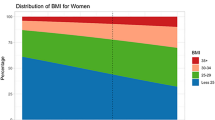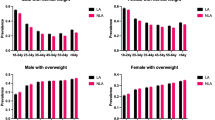Abstract
Background/Objectives:
We aimed to extend the actual overweight discussion with new unbiased Swiss conscript data from 2005 to 2006, and to present for the first time Swiss data on body mass index (BMI) before 1950 and for the late-nineteenth century.
Subjects/Methods:
For this study, 19-year-old Swiss male conscripts (draft army; Cantons Bern, Zurich, Basel-Stadt and Basel-Land) from the census of 1875–1879, 1933–1939 and 2005–2006 (N=28 033; 2005–2006 census) were included. BMI distribution (World Health Organization (WHO) classification) and social stratification (International Labour Organization classification) were main outcome measures.
Results:
Mean BMI of 19-year-old men in Switzerland increased in the 50 years between the 1870s and the 1930s by 0.80 kg/m2 and between the 1930s and 2005 by 1.45 kg/m2. The modern BMI sample is much more right skewed and s.d. is higher. Obesity prevalence (according to modern WHO classification) has increased by a factor of 105 from 1870s until present. Over 23% of our representative sample of Swiss men in 2005–2006 had a BMI of over 25 kg/m2. In 2005–2006, contrary to the nineteenth century, unskilled workers had articulately higher BMI values at the 75th, 90th and 95th percentile than students; 12% of unskilled workers were obese against 2% of students.
Conclusions:
It thus seems that BMI relations between the upper and the lower end of the socio-economic strata changed inversely from the late-nineteenth century to 2005–2006. We further propose that the phenomenon of massive right-skewing BMI distribution between the 1930s and 2005–2006 affected the lower socio-economic strata to a far greater extent than the higher socio-economic group.
This is a preview of subscription content, access via your institution
Access options
Subscribe to this journal
Receive 12 print issues and online access
$259.00 per year
only $21.58 per issue
Buy this article
- Purchase on Springer Link
- Instant access to full article PDF
Prices may be subject to local taxes which are calculated during checkout

Similar content being viewed by others
References
Averett S, Korenman S (1996). The economic reality of the beauty myth. The Journal of Human Resources 31, 304–330.
Baumann N (2008). ‘Sonnenlichtnahrung’ versus gutbürgerliche Fleischeslust. Die ‘richtige’ Ernährung im Spannungsfeld von Ernährungswissenschaft, Körpervermessung und Lebensreformbewegung im schweizerischen Raum zwischen 1890 und 1930. Schweiz Z Geschichte 58, 298–317.
Bernstein M, Costanza M, Morabia A (2001). Physical activity of urban adults: a general population survey in Geneva. Soz Praventiv Med 46, 49–59.
Carson S (2007). Mexican body mass index values in the late 19th-century American west. Econ Hum Biol 5, 37–47.
Cawley J (2004). The impact of obesity on wages. J Hum Resour 39, 451–474.
Costa D (1993). Height, weight, wartime stress and older age mortality. Explor Econ Hist 30, 424–449.
Cuff T (1993). The body mass index values of nineteenth century West Point cadets: a theoretical application of Waaler's curves to a historical population. Hist Method 26, 171–183.
Dina C, Meyre D, Gallina S, Durand E, Körner A, Jacobson et al. (2007). Variation in FTO contributes to childhood obesity and severe adult obesity. Nat Genet 39, 724–726.
Egger S, Wieland R, Ludin M, Brändli O, Vetter W, Suter PM (2001). Übergewicht und Adipositas im Kanton Zürich. Eine LuftiBus-Studie. Praxis 90, 531–538.
Eichholzer M (2002). Körpergewicht der Schweizer Bevölkerung. eine Übersicht zur aktuellen Literatur. Suisse Balance: Zürich.
Eichholzer M, Lüthy J, Gutzwiler F (1999). Epidemiologie des Übergewichts in der Schweiz: Resultate der Schweizerischen Gesundheitsbefragung 1992/93. Swiss Med Wkly 129, 353–361.
Felgal K, Troiano R (2000). Changes in the distribution of body mass index of adults and children in the US populations. Int J Obes 24, 807–818.
Finkelstein E, Ruhm C, Kosa K (2005). Economic causes and consequences of obesity. Annu Rev Public Health 26, 239–257.
Fogel R (1994). Economic growth, population theory and physiology: the bearing of long-term processes on the making of economic policy. Am Econ Rev 84, 369–395.
Galobardes B, Costanza M, Bernstein M, Delhumeau C, Morabia A (2003). Trends in risk factors for lifestyle-related diseases by socio-economic position in Geneva, Switzerland, 1993–2000: health inequality persist. Am J Public Health 93, 1302–1309.
Gortmaker S, Must A, Perrin J, Sobol A, Dietz W (1993). Social and economic consequences of overweight in adolescence and young adulthood. N Engl J Med 329, 1008–1012.
Groscurth A, Vetter W, Suter P (2003). Is the Swiss population gaining body weight? Körpermassenindex bei Versicherungs-Antragsstellern zwischen 1950 und 1990. Praxis 92, 2191–2200.
Gruner E, Wiedmer H (1987). Arbeiterschaft und Wirtschaft in der Schweiz 1880–1914. Chronos: Zürich.
Gubéran E (1980). Tendences de la Mortalité en Suisse, 2: Maladies infectieuses 1876–1977. Swiss Med Wkly 110, 574–583.
Gutiérrez-Fisac J, Guallar-Castillón P, Díez-Gañán L, García EL, Banegas JB et al. (2002). Work-related physical activity is not associated with BMI and obesity. Obes Res 10, 270–276.
Harper B (2000). Beauty, stature and the labour market: a British cohort study. Oxford Bull Econ Statist 62, 771–784.
Helmchen L, Henderson R (2004). Changes in the distribution of body mass index of white US men 1890–2000. Ann Hum Biol 31, 174–181.
Henderson M (2005). The bigger the healthier: are the limits of BMI risk changing over time? Econ Hum Biol 3, 339–366.
Henneberg M, Veitch D (2005). Is obesity as measured by body mass index and waist circumference in adult Australian women 2002 just a result of lifestyle? Hum Ecol 13, 85–89.
Hiermeyer M (2009). Height and BMI values of German conscripts in 2000, 2001 and 1906. Econ Hum Biol 7, 366–375.
Hürlimann J (1880). Ueber die Ergebnisse der Sanitarischen Rekruten-Musterung in der Schweiz während den Jahren 1875–1879. Eine populäre militärärztliche Skizze. Unter-Aegeri.
Huwiler K, Bichsel M, Junker J, Minder C (2002). Soziale Ungleichheit und Gesundheit in der Schweiz Eine Spezialauswertung der Gesundheitsbefragung 1997. Neuenburg: Bundesamt für Statistik.
Instruction über die Untersuchung und Ausmusterung der Militärpflichtigen. Bern (1875–1877).
James P (2001). The worldwide obesity epidemic. Obes Res 9, 228–233.
Katzmarzyk P (2002). The Canadian obesity epidemic: an historical perspective. Obes Res 10, 666–674.
Kinkerlin H (1880). Die Bevölkerung des Kantons Basel-Stadt am 1. Basel, December 1880.
Komlos J, Breitfelder A, Sunder M (2009). The transition to post-industrial BMI-values among US-children. Am J Hum Biol 21, 151–160.
Kurz H (1985). Geschichte der Schweizer Armee. Verlag Huber: Frauenfeld.
Linares S, Su D (2005). Body mass index and health among union army veterans 1891–1905. Econ Hum Biol 3, 367–387.
Lunn P (1991). Nutrition, immunity and infection. In: Schofield R, Reher D, Bideau A (eds) The Decline of Mortality in Europe. Clarendon Press: Oxford. pp 131–145.
Merta S (2003) Wege und Irrwege zum modernen Schlankheitskult Diätkost und Körperkultur als Suche nach neuen Lebensstilformen 1880–1930. Franz Steiner: Stuttgart.
Mohler-Kuo M, Wydler H, Zellweger U, Gutzwiler F (2006). Differences in health status and health behavior among young Swiss adults between 1993 and 2003. Swiss Med Wkly 136, 464–472.
Morabia A, Constanza M (2005). The obesity epidemic as harbinger of a metabolic disorder epidemic: trends in overweight, hypercholesterolemia and diabetes treatment in Geneva, Switzerland, 1993–2003. Am J Public Health 95, 632–635.
Murray J (1997). Standards of the present people for people of the past: height, weight and mortality among men of Amherst College 1834–1949. J Econ Hist 57, 585–606.
Penman A, Johnson W (2006). The changing shape of body mass index distribution curve in the population: implications for public health policy to reduce the prevalence of adult obesity. Prev Chronic Dis 3, 1–4.
Rasmussen F, Johansson M, Hansen H (1999). Trends in overweight and obesity among 18-year-old males in Sweden between 1971 and 1995. Acta Paediatr 88, 431–437.
Riley J (1994). Height, nutrition and mortality risk reconsidered. J Interdiscip Hist 24, 465–492.
Ritzmann-Blickenstorfer H ed) (1996). Historical Statistics of Switzerland. Chronos: Zürich.
Rühli F, Henneberg M, Woitek U (2008). Variability of height, weight and body mass index in a Swiss armed forces 2005 census. Am J Phys Anthropol 137, 457–468.
Rühli F, Woitek U (2007). Rekrutierung: Medizinisch-sozioökonomische Forschung. Amtl Schweiz Mil Z ASMZ 173, 28–29.
Schmid A, Schneider H, Golay A, Keller U (2005). Economic burden of obesity and its comorbidities in Switzerland. Soz Praventiv Med 50, 87–94.
Schneider H, Schmid A (2004) Die Kosten der Adipositas in der Schweiz Schlussbericht des Bundesamtes für Gesundheit (BAG). Basel: Bundesamt für Gesundheit (BAG).
Schopper D (2005). Gesundes Körpergewicht: Wie können wir der Übergewichtsepidemie entgegenwirken? Wissenschaftliche Grundlagen zur Erarbeitung einer Strategie für die Schweiz. Gesundheitsförderung: Bern/Lausanne.
Schütz Y, Woringer V (2002). Obesity in Switzerland: a critical assessment of prevalence in children and adults. Int J Obes 26, 3–11.
Statistisches Amt Basel Stadt (2009) Prozentanteil übergewichtiger Kinder nach Heimat, Geschlecht und Schulstufe seit 1979/1980, erhoben im Rahmen der Schulärztlichen Untersuchungen. http://www.statistik-bs.ch/themen/14/Gesundheitsvorsorge/gewicht
Thoms U (2000). Körperstereotype Veränderungen in der Bewertung von Schlankheit und Fettleibigkeit in den letzten 200 Jahren. In: Wischermann C, Haas S (eds) Körper mit Geschichte. Franz Steiner: Stuttgart. pp 281–308.
Trevisan L (1989). Das Wohnungselend der Basler Arbeiterbevölkerung in der zweiten Hälfte des 19 Jahrhunderts Neujahrsblatt der Gesellschaft für das Gute und Gemeinnützige, 168, 5–125.
Vignerova J, Humenikova L, Brabec M, Riedlova J, Blaha P (2007). Long-termed changes in body weight, BMI and adiposity rebound among children and adolescents in the Czech Republic. Econ Hum Biol 5, 409–425.
WHO (1998–2004). Consultation on obesity. Obesity: Preventing and Managing the Global Epidemic. Report of a WHO Consultation. World Health Organization (WHO): Geneva.
Waaler H (1984). Height, weight and mortality: the Norwegian experience. Acta Med Scand 679, 1–56.
Wietlisbach V, Pauccaud F, Rickenbach M, Gutzwiler F (1997). Trends in cardiovascular risk factors (1984–1993) in a Swiss region: results of three population surveys. Prev Med 26, 523–533.
Wolf P (1891) Die Schweizerische Bundesgesetzgebung: nach Materien geordnete Sammlung der Gesetze, Beschlüsse, Verordnungen und Staatsverträge der Schweizerischen Eidgenossenschaft sowie der Konkordate. Kreis: Basel.
Zagorsky J (2005). Health and wealth—the late-20th century obesity epidemic in the US. Econ Hum Biol 3, 296–313.
Acknowledgements
Kaspar Staub and Christian Pfister were supported by Swiss National Science Foundation (Project-No. 109802) and by Swiss Foundation for Nutrition Research.
Author information
Authors and Affiliations
Corresponding author
Rights and permissions
About this article
Cite this article
Staub, K., Rühli, F., Woitek, U. et al. BMI distribution/social stratification in Swiss conscripts from 1875 to present. Eur J Clin Nutr 64, 335–340 (2010). https://doi.org/10.1038/ejcn.2010.7
Received:
Revised:
Accepted:
Published:
Issue Date:
DOI: https://doi.org/10.1038/ejcn.2010.7
Keywords
This article is cited by
-
Changes in the role of explanatory factors for socioeconomic inequalities in physical performance: a comparative study of three birth cohorts
International Journal for Equity in Health (2021)
-
Socioeconomic inequalities in childhood-to-adulthood BMI tracking in three British birth cohorts
International Journal of Obesity (2020)
-
Finding big shots: small-area mapping and spatial modelling of obesity among Swiss male conscripts
BMC Obesity (2016)
-
Obesity prevalence and unfavorable health risk behaviors among German kindergarten teachers: cross-sectional results of the kindergarten teacher health study
BMC Public Health (2013)
-
Fuzzy obesity index (MAFOI) for obesity evaluation and bariatric surgery indication
Journal of Translational Medicine (2011)



